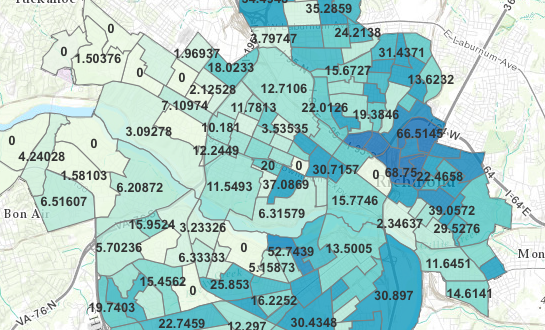RECENT COMMENTS
Joel Cabot on Power Outage on the Hill
Eric S. Huffstutler on What is up with the Church Hill Post Office?
Eric S. Huffstutler on What is up with the Church Hill Post Office?
Yvette Cannon on What is up with the Church Hill Post Office?
crd on Power Outage on the Hill

Percentage of households with no car
01/08/2015 6:15 AM by John M
From the city website: “Census Block Groups by percentage of households w/no access to a car. Last Modified: December 18, 2014″
— ∮∮∮ —







I’m one of those households with no access to a car. For the most part, it’s a non-issue. Public transportation is really good. My only request would be more shelters at bus stops. With our recent cold weather, waiting out in the open sometimes up to an hour, can be a bit difficult. There’s seniors, like myself, young parents with children, a real mix of people. If you don’t use public transport, you probably never give it a thought.
Best,
Rita on 31st.
Jeez — With so few cars, you’d think it would be easier to find a convenient parking space!
Seriously, though, I absolutely agree with Rita: We do need more bus shelters. (We also need smarter people planning routes and schedules, but that’s another matter.)
One of the hidden (to some folks) treasures of our neighborhood is how many bus lines are within walking distance of Union Hill and Church Hill (Chimborazo really only gets two). I get to have my pick of bus lines that run by bakeries in the morning and can always get a bus within 6 minutes if I walk down to 21st and Marshall.
@6, it’s not always that great with bus lines. I was talking to a young lady recently who spent some time living in Fulton during the winter, and said she felt totally isolated….she remembered one time waiting for nearly an hour for a bus in freezing temps, and finally giving up and going home to blow off the meeting she was supposed to go to. I have a sense that Fulton is still sort of isolated, but it IS part of the East End, and part of what CHPN covers.
It is my understanding that the CHA Transportation Committee wants to address ALL transportation needs in the east end, including greater Fulton. I hope that comes to pass.
The #45 stop going toward downtown is one street over so I use that a lot. Often I ask for a transfer to catch the #7 going east so I can shop at a regular grocery (cheaper for the fixed income). I get off at 25/M and catch the #7 at 25 and Cedar.
Overall, I give the GRTC high marks.
Another wish list is more sidewalks! If you walk a lo, you soon find out there’s no rhyme or reason to the lay out. You would think they would all be on one side (both sides would be great!). They’re not. If you want to stay on a sidewalk, you have to keep crossing back and forth. That’s the reasons people walk in the street, including me at times. I’ve noticed this is worse on the lettered streets than the numbered ones.
That’s my (long-winded) response.
🙂
The transfer plaza has made getting from the east end of town to the west end longer and more difficult.
We used to be able to take a bus on Marshall all the way up Monument and Patterson in a single direct trip – total time about 30 -40 minutes. That same trip now requires stopping a the transfer plaza, in the freezing cold, maybe in the dark with some sketchy people hanging around, and waiting for your transfer bus.. If you are lucky, it didn’t leave before your bus came in, and you have about 5 -10 minute wait, total trip time 45 -55 minutes If not, your wait will be 45 minutes, making you a hour late to where ever you were going.
To be a great system, they really need more busses. During rush hour, the busses do usually come about 20 minutes apart. Once it’s over, you are really in trouble. It may be nearly an hour between busses.
I really don’t think the transfer plaza has improved the bus system at all. It is less confusing with only one transfer station, but the wait time can really turn off new riders. And there is now way we could expand the fleet and have shorter waits without a large enough ridership.
Does anyone know what formula they used to come up with these figures? House by house? Population per land mass? Or what? I ask because I am seeing the very high numbers falling in areas that are either undeveloped or industrial.
Like someone asked, how could some neighborhoods show medium numbers and still have parking issues? I think it is in part that people from outside the neighborhood will park to carpool with others as well as visit local businesses – like our issue with Dutch & Co. on the 400 block of N 27th during peak hours.
We will never have the age pre WWII where most families only had one car if that and depended on trolley and bus transportation that were everywhere then running every couple of minutes.